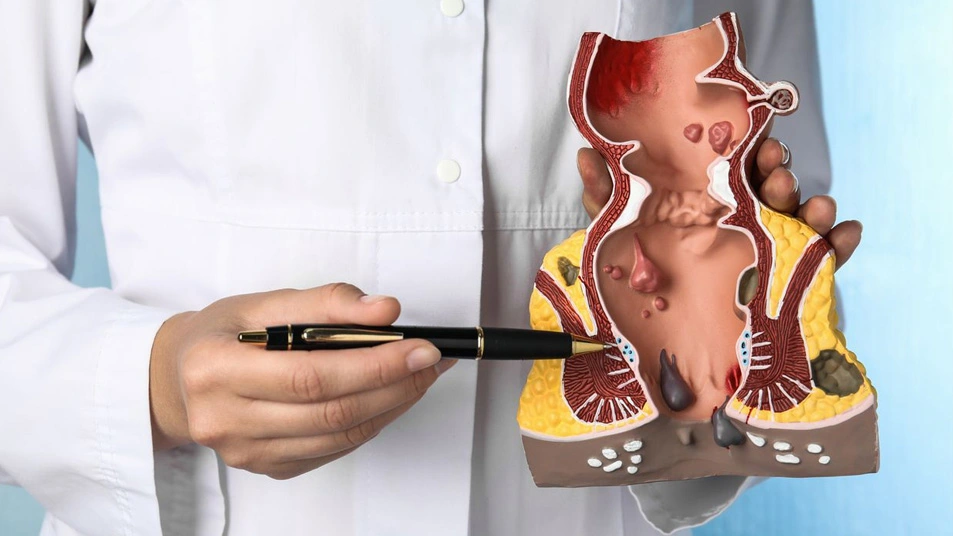
Anal Fissure Treatment, Fissure Specialist in Konkan
A rip or break in the anal canal lining is called an anal fissure. It is frequently the source of rectal bleeding and anal pain, particularly during pooping.
A fissure is typically caused by anal trauma, particularly while straining to pass firm feces. Anal cracks may develop gradually or abruptly. They may also recover swiftly or gradually.
Symptoms of Anal Fissures :
The most common symptoms are :
Irritation when passing gas.
Itching or burning when passing gas.
Vibrant, fresh blood in your stool.
Some people may also have Spasms in the anal.
A swollen area of skin close to the rip.
Causes of Anal Fissures :
The anal lining tears as a result of trauma such as stretching and straining. Preexisting conditions, however, may also be relevant. This relates to the structure of the anus, or butthole, which is actually the final few centimeters of large intestine, a lengthy, muscular tube.
The skin of anus resembles the skin outside of the body more at the end where it opens to the outside. However, the same soft mucosa that lines the remainder of large intestine also lines the top part of anus, where fissures typically occur.
This mucous membrane is more brittle and easily torn than regular skin because it is thinner. Particularly for infants, who frequently develop anal fissures. It may also become inflamed due to an illness or accident. Chronic inflammation that lasts a long time might erode the tissues.
The two circular muscles that encircle the Anus are called Anal Sphincters, and they aid in controlling the bowel motions. The anal lining may become more tense if these muscles are too stiff, which might lead to an easier rip or even less blood supply to the affected areas.
Primary causes of anal fissures include :
Constant
constipation and difficulty passing gas.
The syndrome of obstructed defecation.
Dyschezia in infants.
Persistent diarrhea.
Childbirth.
Penetration.
Other contributing conditions include :
Previous medical procedures.
IBD, or inflammatory bowel illness.
Cancer of the anus.
TB, or tuberculosis.
Rashes from diapers.
Diagnosis of Anal Fissures :
The healthcare practitioner will probably inquire the patient about their medical history before doing a physical examination that may involve a mild examination of the anal area, The rip is often noticeable. To identify an anal fissure, this exam is typically sufficient.
An acute anal fissure that has just developed resembles a new tear, akin to a paper cut. Long-lasting anal fissures, also known as chronic fissures, most likely have a deeper tear. There might also be fleshy growths on the inside or outside of it.
For fissures that last longer than eight weeks, they are classified as chronic.
The position of the fissure provides hints regarding its cause. If the fissure appears on the side of the anal entrance instead than the front or rear, it is more likely to be a sign of another illness, such Crohn's disease. In order to determine whether a patient have an underlying problem, the provider can advise more tests
Tests may include :
Anoscopy : A tube instrument called an anoscope is placed into the anus to aid your physician in seeing the rectum and anus.
Flexible sigmoidoscopy : A thin, flexible tube with a small video is inserted into the bottom part of the colon by the healthcare professional. If the patient is under 45 and do not have any risk factors for colon cancer or digestive disorders, they may be able to get this test.
Colonoscopy : A flexible tube is inserted into the rectum to examine whole colon during this procedure. Patient might have a to do colonoscopy if:
Are over 45 years old.
Have colon cancer risk factors.
Display signs of further ailments.
Experience additional symptoms, such diarrhea or stomach ache.
Treatment for Anal Fissures :
Anal fissures may commonly heal at home in a matter of weeks when the right care is given. Patient must get enough fiber and water to help maintain the softness of their stools. Many times, during the day, especially after bowel motions, soak in warm water for ten to twenty minutes. This may aid in sphincter relaxation and healing. If the symptoms continues then the patient have to take more care.
Nonsurgical treatments :
Your health care provider may recommend :
Nitroglycerin applied externally (Rectiv) may facilitate healing by boosting blood flow to the fracture. It may also aid in the anal sphincter's relaxation. In most cases, nitroglycerin is the recommended course of action when more cautious approaches are ineffective. A headache, which can be quite severe, is one possible side effect.
Blood pressure medications to assist relax the anal sphincter, such as diltiazem or nifedipine. Although these medications are often used topically, they can also be swallowed. They may, however, have more negative consequences if swallowed. In cases where nitroglycerin is ineffective or has severe adverse effects, these medications may be utilized.
Surgery for Anal Fissure :
The doctor could advise surgery if the symptoms are severe or have a persistent anal fissure that is not responding to previous therapies. The operation known as lateral internal sphincterotomy (LIS) is typically carried out by doctors. A little part of the anal sphincter muscle is severed during LIS. This method might lessen discomfort and spasms while accelerating recovery.
According to studies, surgery is far more successful in treating persistent fissures than any other medical intervention. On the other hand, incontinence is a minor risk associated with surgery.
Post Surgery Precautions for Anal Fissure :
Use a stool softener to make defecating more pleasant. Place the hips in a squatting posture by using a step stool to support the feet while sitting on the toilet.
Use gentle paper or damp wipes without alcohol to gently clean the anus. After pooping, think about taking a shower or using a bidet.
Use a topical lotion or ointment on your fissure as it acts as antibiotic and retains moisture. Petroleum jelly can aid in the healing process. Pain and inflammation can be managed with medicated creams.
Spend at least ten to fifteen minutes sitz bathing two or three times a day. Sit in this little bath of heated water to soak the ass. It can assist in muscular relaxation and discomfort relief.
